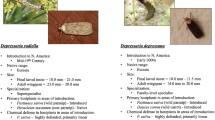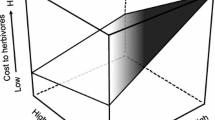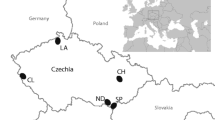Abstract
To be considered a dietary specialist, mammalian herbivores must consume large quantities of a plant species considered “difficult” with respect to nutrient or toxin content, and possess specialized adaptations to deal with plant defensive compounds or low nutritional content. Populations of Neotoma lepida in the Great Basin consume Juniperus osteosperma, a plant heavily defended by terpenes, but a detailed dietary analysis of this population is lacking. Therefore, we investigated the extent of dietary specialization in this species in comparison with the better-studied specialist species, N. stephensi. Microhistological analysis of feces from N. lepida revealed that greater than 90 % of their diet in nature was comprised of juniper. In laboratory tolerance trials, N. lepida tolerated a diet of 80 % J. osteosperma, similar to that observed for N. stephensi. There was no difference in the abilities of N. lepida and N. stephensi to metabolize hexobarbital, a proxy compound for terpene metabolism. In preference tests of native and non-native juniper species, N. lepida did not exhibit a preference for its native or co-occurring juniper, J. osteosperma, over the non-native species, J. monosperma, whereas N. stephensi preferred its native or co-occurring juniper J. monosperma over non-native J. osteosperma. Behavioral and habitat differences between these woodrat species lead to the categorization of N. stephensi as an obligate juniper specialist with a small range that overlaps that of its preferred food, J. monosperma, and N. lepida as a facultative juniper specialist with a large range, and only a portion of its distribution containing populations that feed extensively on J. osteosperma.





Similar content being viewed by others
References
Adams RP (1994) Geographic variation in the volatile terpenoids of Juniperus monosperma and J. osteosperma. Biochem Syst Ecol 22:65–71
Adams RP, Skopec MM, Kohl KD, Dearing MD (2014) Comparison of volatile leaf terpenoids from Juniperus monosperma and J. osteosperma leaves: intact, ground and exposed to ambient temperature. Phytologia 96:207–217
Anderson JR, Scott CB, Taylor CA, Owens CJ, Jackson JR, Steele DK, Brantley R (2013) Using experience and supplementation to increase juniper consumption by three different breeds of sheep. Rangel Ecol Manag 66:204–208
Bentacourt JL, Van Devender TR, Martin PS (1990) Packrat middens: the last 40,000 years of biotic change. University of Arizona Press, Tuscon
Brown JH, Lieberman GA, Dengler WF (1972) Woodrats and cholla : dependence of a small mammal population on the density of cacti. Ecology 53:310–313
Cameron GN, Rainey DG (1972) Habitat utilization by Neotoma lepida in the Mohave desert. J Mammal 53:251–266
Dearing MD (2013) Temperature-dependent toxicity in mammals with implications for herbivores: a review. J Comp Physiol B Biochem Syst Environ Physiol 183:43–50
Dearing M, Cork S (1999) Role of detoxification of plant secondary compounds on diet breadth in a mammalian herbivore, Trichosurus vulpecula. J Chem Ecol 25:1205–1219
Dearing MD, Mangione AM, Karasov WH (2000) Diet breadth of mammalian herbivores: nutrient versus detoxification constraints. Oecologia 123:397–405
Dearing MD, Mangione AM, Karasov WH (2001) Plant secondary compounds as diuretics: an overlooked consequence. Am Zool 41:890–901
Dearing MD, Mangione AM, Karasov WH (2002) Ingestion of plant secondary compounds causes diuresis in desert herbivores. Oecologia 130:576–584
Dearing MD, Skopec MM, Bastiani MJ (2006) Detoxification rates of wild herbivorous woodrats (Neotoma). Comp Biochem Physiol A Mol Integr Physiol 145:419–422
Dial KP (1988) Three sympatric species of Neotoma: dietary specialization and coexistence. Oecologia 76:531–537
Estell RE, Utsumi SA, Cibils AF, Anderson DM (2014) Is differential use of Juniperus monosperma by small ruminants driven by terpenoid concentration? J Chem Ecol 40:285–293
Falk AA, Hagberg MT, Lot AE, Wigaeus-Hjelm EM, Zhiping W (1990) Uptake, distribution and elimination of α-pinene in man after exposure by inhalation. Scand J Work Environ Health 16:372–378
Flinders JT, Hansen RM (1972) Diets and habitats of jackrabbis in northeastern Colorado. Range Sci Dep Sci Ser 12:1–18
Forister ML, Novotny V, Panorska A et al (2015) The global distribution of diet breadth in insect herbivores. Proc Nat Acad Sci USA 112:442–447
Fox LR, Morrow, PA (1981) Specialization: speceis property or local phenomenon? Science 211:887–893.
Freeland WJ, Janzen DH (1974) Strategies in herbivory by mammals: the role of plant secondary compounds. Am Nat 108:269–289
Gershenzon J, Dudareva N (2007) The function of terpene natural products in the natural world. Nat Chem Biol 3:408–414
Hayes JP (1996) Arborimus longicaudis. Mamm Species 532:1–5
Karasov WH (1989) Nutritional bottleneck in a herbivore, the desert wood rat (Neotoma lepida). Physiol Zool 62:1351–1382
Kohl KD, Miller AW, Marvin JE, Mackie F, Dearing MD (2014a) Herbivorous rodents (Neotoma spp.) harbour abundant and active foregut microbiota. Environ Microbiol 16:2869–2878
Kohl KD, Weiss RB, Cox J, Dale C, Dearing MD (2014b) Gut microbes of mammalian herbivores facilitate intake of plant toxins. Ecol Lett 17:1238–1246
Kurnath P, Dearing MD (2013) Warmer ambient temperatures depress liver function in a mammalian herbivore. Biol Lett 9:20130562
Lee ET, Wang J (2003) Statistical methods for survival data analysis. Wiley, Hoboken
MacMillen RE (1964) Population ecology, water relations, and social behavior of a southern California desert rodent fauna. Univ Calif Publ Zool 71:1–66
Magnanou E, Malenke JR, Dearing MD (2009) Expression of biotransformation genes in woodrat (Neotoma) herbivores on novel and ancestral diets: identification of candidate genes responsible for dietary shifts. Mol Ecol 18:2401–2414
Malenke JR, Magnanou E, Thomas K, Dearing MD (2012) Cytochrome P450 2B diversity and dietary novelty in the herbivorous, desert woodrat (Neotoma lepida). PLoS One 7:e41510
Malenke JR, Skopec MM, Dearing MD (2014) Evidence for functional convergence in genes upregulated by herbivores ingesting plant secondary compounds. BMC Ecol 14:23
Marsh KJ, Wallis IR, Andrew RL, Foley WJ (2006) The detoxification limitation hypothesis: where did it come from and where is it going? J Chem Ecol 32:1247–1266
McEachern MB, Eagles-Smith CA, Efferson CM, Van Vuren DH (2006) Evidence for local specialization in a generalist mammalian herbivore, Neotoma fuscipes. Oikos 113:440–448
Murphy SM, Linhart YB (1999) Comparative morphology of the gastrointestinal tract in the feeding specialist Scirurus aberti and several generalist congeners. J Mammal 80:1325–1330
Patton JL, Huckaby DG, Alvarez-Castaneda ST (2014) The evolutionary history and a systematic revision of woodrats of the Neotoma lepida group. UC Publication in Zoology, Oakland
Post DM, Post DM, Reichman OJ, Wooster DE (1993) Characteristics and significance of the caches of eastern woodrats (Neotoma floridana). J Mammal 74:688–692
Rausher, MD (1992). Natural selection and the evolution of plant-insect interactions. In: Roitberg K, Isman MB (eds) Insect chemical ecology: an evolutionary approach. Chapman and Hall, New York, p 20–88
Savolainen H, Pfäffli P (1978) Effects of long-term turpentine inhalation on rat brain protein metabolism. Chem Biol Interact 21:271–276
Schwartz CC, Nagy JG, Regelin WL (1980) Juniper oil yield, terpenoid concentration, and effects on deer. J Wildl Manag 44:107–113
Shipley LA, Forbey JS, Moore BD (2009) Revisiting the dietary niche: when is a mammalian herbivore a specialist. Integr Comp Biol 49:274–290
Skopec MM, Haley S, Dearing MD (2007) Differential hepatic gene expression of a dietary specialist (Neotoma stephensi) and generalist (Neotoma albigula) in response to juniper (Juniperus monosperma) ingestion. Comp Biochem Physiol D Genomics Proteomics 2:34–43
Skopec MM, Malenke JR, Halpert JR, Dearing MD (2013) An in vivo assay for elucidating the importance of cytochromes P450 for the ability of a wild mammalian herbivore (Neotoma lepida) to consume toxic plants. Physiol Biochem Zool 86:593–601
Smith FA, Murray IW, Harding LE, Lease HM, Martin J (2014) Life in an extreme environment: a historical perspective on the influence of temperature on the ecology and evolution of woodrats. J Mammal 95:1128–1143
Sorensen JS, Dearing MD (2003) Elimination of plant toxins by herbivorous woodrats: revisiting an explanation for dietary specialization in mammalian herbivores. Oecologia 134:88–94
Sorensen JS, McLister JD, Dearinga MD (2004) Plant secondary metabolites compromise the energy budgets of specialist and generalist mammalian herbivores. Ecology 86:125–139
Sorensen JS, Mclister JD, Dearing MD (2005) Novel plant secondary metabolites impact dietary specialists more than generalists (Neotoma spp.). Ecology 86:140–154
Sperling F, Marcus WL, Collins C (1967) Acute effects of turpentine vapor on rats and mice. Toxicol Appl Pharmacol 10:8–20
Stones RC, Hayward CL (1968) Natural history of the desert woodrat, Neotoma lepida. Am Midl Nat 80:458–476
Torregrossa A-M, Dearing MD (2009) Caching as a behavioral mechanism to reduce toxin intake. J Mammal 90:803–810
Torregrossa AM, Azzara AV, Dearing MD (2011) Differential regulation of plant secondary compounds by herbivorous rodents. Funct Ecol 25:1232–1240
Vaughan TA, Czaplewski NJ (1985) Reproduction in Stephens’ woodrat: the wages of folivory. J Mammal 66:429–443
Verts BJ, Carraway LN (2002) Neotoma lepida. Mamm Species 699:1–12
Wilderman PR, Jang HH, Malenke JR, Salib M, Angermeier E, Lamime S, Dearing MD, Halpert JR (2014) Functional characterization of cytochromes P450 2B from the desert woodrat Neotoma lepida. Toxicol Appl Pharmacol 274:393–401
Zahler P, Khan M (2003) Evidence for dietary specialization on pine needles by the woolly flying squirrel (Eupetaurus cinereus). J Mammal 84:480–486
Zlatnik E (1999) Juniperus osteosperma. In: Fire Eff. Inf. Syst. http://www.fs.fed.us/database/feis. Accessed 10 Jun 2014
Acknowledgments
We thank Andrew Corbin for his adept technical assistance. Support for this research came from NSF (IOS 1256383 and IOS 1461359).
Author information
Authors and Affiliations
Corresponding author
Rights and permissions
About this article
Cite this article
Skopec, M.M., Kohl, K.D., Schramm, K. et al. Using the Specialization Framework to Determine Degree of Dietary Specialization in a Herbivorous Woodrat. J Chem Ecol 41, 1059–1068 (2015). https://doi.org/10.1007/s10886-015-0654-y
Received:
Revised:
Accepted:
Published:
Issue Date:
DOI: https://doi.org/10.1007/s10886-015-0654-y




